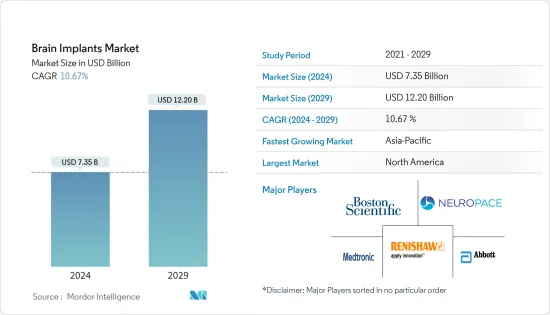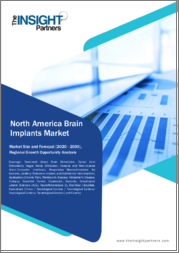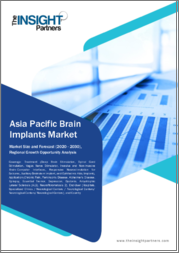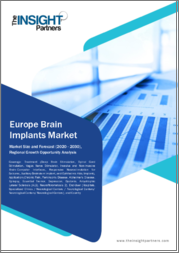
|
시장보고서
상품코드
1438089
세계의 뇌 임플란트 시장 : 점유율 분석, 산업 동향 및 통계, 성장 예측(2024-2029년)Brain Implants - Market Share Analysis, Industry Trends & Statistics, Growth Forecasts (2024 - 2029) |
||||||
뇌 임플란트(Brain Implants) 시장 규모는 2024년에 73억 5,000만 달러로 추정되며, 2029년까지 122억 달러에 이를 것으로 예측되며, 예측 기간(2024-2029년) 동안 10.67%의 CAGR로 추이하며 성장할 전망입니다.

COVID-19 팬데믹은 대부분의 선택적 수술과 치료의 중단 및 연기로 인해 전 세계 뇌 임플란트 시장 성장에 큰 영향을 미쳤습니다. 2021년 medRXiV에 발표된 연구 논문에 따르면 파킨슨병 환자의 SARS-COV2 바이러스 감염 유병률은 11.28%인 것으로 밝혀졌습니다. 또한, 뇌심부자극술을 받은 파킨슨병 환자의 COVID-19 유병률은 18.18%인 것으로 밝혀졌습니다. 따라서 COVID-19에 걸린 환자는 입원 기간 동안 신경 장애가 발생할 위험이 높습니다. 바이러스 전파를 억제하기 위한 엄격한 봉쇄 제한과 조치는 만성 스트레스와 신경 장애의 부담을 증가시켰습니다. 이로 인해 신경과 외래 서비스의 긴급한 개설이 증가했습니다. 따라서 뇌 임플란트 시장은 팬데믹 기간 동안 상당한 영향을 받았습니다. 그러나 팬데믹 기간 동안 신경과 수술은 발전했습니다. 예를 들어, 2021년 3월, 스프링거 네이처에 게재된 한 논문에서는 팬데믹 초기 단계에 대한 신경외과계의 대응이 최소 3개 유럽 국가에서 높은 수준의 치료와 낮은 급성 사망률을 유지했다고 밝혔습니다. 이와 유사하게, 2021년 12월 Frontiers Media S.A.에 게재된 또 다른 기사에서는 팬데믹이 진화함에 따라 신경 및 정신 질환 환자를 위한 원격 의료 서비스의 배치가 급격히 증가했다고 밝혔습니다. 형식, 일정, 개인정보 보호, 환급에 대한 우려에도 불구하고 환자 만족도를 강조하는 수많은 보고서가 발표되면서 비교적 순조롭게 전환되었습니다. 따라서 수술의 정상화와 새로운 방법의 도입은 시장 성장을 증가시킬 것으로 예상됩니다.
뇌 임플란트 시장 성장의 주요 요인으로는 고령화 인구의 증가, 신경계 질환 유병률 증가, 기기 기술 발전 등이 있습니다. 알츠하이머, 간질, 파킨슨병, 우울증, 본태성 떨림과 같은 신경계 질환의 증가는 뇌 임플란트에 대한 수요를 촉진할 것으로 예상됩니다. 파킨슨병 뉴스 투데이 2021에 따르면 전 세계적으로 약 700만-1000만 명이 파킨슨병을 앓고 있으며, 약 6만 명의 미국인이 이 질환을 진단받고 있어 성장 가능성이 높은 것으로 추정됩니다. 마찬가지로 파킨슨 재단 2020에 따르면 2030년까지 미국에서는 약 120만 명이 파킨슨병을 앓을 것으로 예상됩니다. 뇌 임플란트는 파킨슨병이나 기타 신경 질환을 앓고 있는 환자의 만성 통증을 완화하고 신체 움직임을 개선하는 약물의 필요성을 줄여줄 수 있을 것으로 보입니다.
노인 인구가 증가함에 따라 여러 신경 질환이 발생하기 쉽습니다. 세계보건기구(WHO)의 2021년 10월 업데이트에 따르면 2030년에는 전 세계 인구 6명 중 1명이 60세 이상이 될 것이며, 2050년에는 전 세계 60세 이상 인구의 3분의 2가 저소득 및 중간 소득 국가에 거주할 것으로 예상됩니다. 이러한 중간 소득 국가에서는 현재의 인프라로는 치료와 지속적인 모니터링을 제공할 수 없으며, 뇌 임플란트가 이러한 지역에서 이를 제공할 수 있습니다. 따라서 노인 인구가 증가함에 따라 뇌 임플란트 시장은 예측 기간 동안 상당한 성장을 기록할 것으로 예상됩니다.
또한 주요 시장 참여자들의 협업은 연구 개발의 시너지 효과를 제공하고 프로그램의 성공률을 높이는 데 필요한 투자를 제공하므로 시장 성장을 증가시킬 것으로 예상됩니다. 예를 들어, 2022년 4월 퀸즐랜드 뇌 연구소(QBI)와 뉴로사이언스 퀸즐랜드, 애보트 뉴로모듈레이션의 공동 프로젝트는 환자가 전 세계 어디서나 치료에 접근할 수 있도록 뇌 이식 기술에 무선 기술을 사용하는 원격 치료 플랫폼을 개발했습니다. 이 새로운 기술은 뇌에 이식하는 임플란트와 같은 뇌 판독 장치 개발과 연결될 것입니다. 따라서 신경 장애의 유병률 증가 및 협업과 같은 위에서 언급 한 요인은 예측 기간 동안 시장 성장을 증가시킬 것으로 예상됩니다. 그러나 개발도상국 및 저개발 지역의 높은 장치 비용과 낮은 채택률은 시장 성장을 저해할 것으로 예상됩니다.
뇌 임플란트 시장 동향
알츠하이머병은 예측 기간 동안 뇌 임플란트 시장에서 상당한 성장을 유지할 것으로 예상
알츠하이머병은 환자의 기억력에 영향을 미치는 신경 질환으로 시간이 지남에 따라 악화되는 경우가 많습니다. 알츠하이머병의 유병률 증가와 보조금과 같은 이니셔티브 증가와 같은 요인이 시장 성장을 증가시킬 것으로 예상됩니다. 알츠하이머 발병률은 지속적으로 증가하고 있으며 향후 수십 년 동안 계속 증가할 것으로 예상됩니다. 알츠하이머 협회의 2021년 알츠하이머병 실태 및 수치 보고서에 따르면 2021년 미국에서는 65세 이상 미국인 약 620만 명이 알츠하이머 치매를 앓고 있는 것으로 추정됩니다. 2050년에는 65세 이상의 알츠하이머 치매 환자 수가 1,270만 명으로 늘어날 것으로 예상됩니다. 2021년 9월에 발표된 세계 알츠하이머 보고서에 따르면 전 세계적으로 5,500만 명 이상의 사람들이 치매를 앓고 있습니다. 2030년에는 그 수가 7,800만 명에 달할 것으로 예상됩니다. 전체 치매 질환 중 알츠하이머병이 60-70%를 차지합니다. 다양한 연구를 통해 뇌 임플란트가 알츠하이머병에 미치는 영향에 대한 인사이트를 얻을 수 있습니다. 예를 들어, 2022년 11월 신경 공학 저널에 발표된 연구에 따르면 연구팀은 87.4%에서 97.6%의 민감도로 발작 이벤트를 감지할 수 있는 딥러닝 방법을 개발했다고 합니다. 연구팀은 이러한 치료법을 알츠하이머병에 적용하는 방안도 연구하고 있습니다. '수면 장애는 알츠하이머와 관련이 있으며, 많은 사람들이 다양한 수준의 수면 장애로 고통받고 있습니다. 따라서 뇌 임플란트는 알츠하이머병 환자의 인지 기능을 개선할 수 있으며, 이것이 알츠하이머병 환자들이 뇌 임플란트 시술을 선호하는 이유입니다. 따라서 알츠하이머병 환자의 수가 증가함에 따라 예측 기간 동안 뇌 임플란트 시장을 주도할 것으로 예상됩니다.
또한 알츠하이머병 관련 연구에 대한 보조금 증가도 시장 성장의 또 다른 요인입니다. 2021년 4월, 정부는 알츠하이머병의 조기 발견과 치료에 초점을 맞춘 세계적 수준의 연구 프로그램을 구축하기 위해 브라운 대학교에 3천만 달러를 투자하여 새로운 알츠하이머병 연구 센터를 설립했습니다. 2021년 1월, 코그니토 테라퓨틱스는 알츠하이머병의 기억력 및 인지 증상을 치료하는 신경 자극 장치로 미국 식품의약국(FDA)으로부터 획기적인 장치 지정을 받았습니다. 따라서 알츠하이머병의 높은 발병률과 투자 증가는 예측 기간 동안 해당 부문의 상당한 성장에 도움이 될 것으로 예상됩니다.
북미는 예측 기간 동안 뇌 임플란트 시장에서 상당한 시장 점유율을 유지할 것으로 예상
북미는 뇌 임플란트 시장에서 상당한 점유율을 차지하고 있습니다. 예측 기간 동안 큰 변동 없이 비슷한 추세를 보일 것으로 예상됩니다. 이 나라의 의료 시설은 최고 수준이며 지역 인구 대다수가 의료 서비스를 이용할 수 있도록하는 유리한 정책으로 인해 많은 인구가 접근 할 수 있습니다. 이 요인은 전국적으로 더 높은 판매율을 달성하는 데 도움이 됩니다. 다양한 신경 장애의 유병률과 발병률이 증가함에 따라 뇌 임플란트 시장 수요에 대한 잠재력이 커지고 있습니다. 2022년 알츠하이머 협회의 알츠하이머병 현황 및 수치 보고서에 따르면, 2022년 65세 이상 미국인 약 650만 명이 알츠하이머 치매를 앓고 있는 것으로 추정됩니다. 그리고 65세 이상 인구 9명 중 1명은 알츠하이머 치매를 앓고 있습니다. 마찬가지로 알츠하이머 협회 2022 보고서에 따르면 지난해 멕시코에서 예상되는 알츠하이머 관련 사망자 수는 43,000명이지만 2025년에는 최대 53,000명에 이를 것으로 예상됩니다. 따라서 이러한 질병을 진단하고 치료해야 할 필요성으로 인해 뇌 임플란트와 관련된 신경학적 치료에 대한 수요가 증가하여 멕시코 내 제품 제조 회사 수가 증가할 것으로 예상됩니다. 신경 장애의 사례가 증가함에 따라 북미 지역, 특히 미국의 시장은 향후 몇 년 동안 꾸준한 속도로 성장할 것으로 예상됩니다.
또한 뇌 임플란트에 대한 승인은 시장 성장을 더욱 가속화할 것으로 예상됩니다. 뇌 임플란트의 제품 승인으로 신경계 질환에 대한 채택이 증가할 것으로 예상되기 때문입니다. 예를 들어, 2022년 10월, 신경 기술 회사인 Axoft는 신경 장애를 더 잘 치료할 수 있는 뇌-기계 인터페이스(BMI)로 FDA 혁신 기기(Breakthrough Device) 지정을 받았습니다. 이 회사는 FDA의 전임상 연구와 "뇌처럼 부드러운" 신경 임플란트의 프로토타입을 확장하기 위해 800만 달러의 자본을 확보했습니다. 따라서 신경 장애의 유병률 증가 및 제품 승인과 같은 앞서 언급 한 요인으로 인해 북미 뇌 임플란트 시장은 예측 기간 동안 상당한 성장을 목격 할 것으로 예상됩니다.
뇌 임플란트 산업 개요
뇌 임플란트 시장은 소수의 주요 기업의 존재에 의해 적당하게 통합됩니다. 시장 참가자로는 Abbott Laboratories, Boston Scientific Corporation, LivaNova PLC, Medtronic PLC, NDI Medical PLC, NeuroPace Inc., NeuroSigma, Synchron Inc., Renishaw PLC 등이 있습니다.
기타 혜택
- 엑셀 형식 시장 예측(ME) 시트
- 3개월의 애널리스트 서포트
목차
제1장 서론
- 조사 전제 조건 및 시장 정의
- 조사 범위
제2장 조사 방법
제3장 주요 요약
제4장 시장 역학
- 시장 개요
- 시장 성장 촉진 요인
- 고령화 인구 증가와 신경 질환의 유병률 증가
- 디바이스의 기술 진보
- 시장 성장 억제 요인
- 높은 디바이스 비용
- 개발도상지역 및 저개발지역에서 낮은 도입률
- Porter's Five Forces 분석
- 신규 참가업체의 위협
- 구매자의 협상력
- 공급기업의 협상력
- 대체 제품의 위협
- 기업 간 경쟁 정도
제5장 시장 세분화
- 제품 유형별
- 심부 뇌 자극 장치
- 척수 자극 장치
- 미주 신경 자극 장치
- 용도별
- 만성 통증
- 간질
- 파킨슨병
- 우울
- 본태성 진전
- 알츠하이머병
- 기타 용도
- 지역별
- 북미
- 미국
- 캐나다
- 멕시코
- 유럽
- 독일
- 영국
- 프랑스
- 이탈리아
- 스페인
- 기타 유럽
- 아시아 태평양
- 중국
- 일본
- 인도
- 호주
- 한국
- 기타 아시아 태평양
- 중동 및 아프리카
- GCC
- 남아프리카공화국
- 기타 중동 및 아프리카
- 남미
- 브라질
- 아르헨티나
- 기타 남미
- 북미
제6장 경쟁 구도
- 기업 개요
- Abbott Laboratories
- Boston Scientific Corporation
- LivaNova Plc
- Medtronic Plc
- NDI Medical PLC
- NeuroPace Inc.
- NeuroSigma
- Synchron Inc.
- Renishaw Plc
- Fisher Wallace
- Functional Neuromodulation, Ltd.
- Stimwave LLC
제7장 시장 기회 및 향후 동향
LYJThe Brain Implants Market size is estimated at USD 7.35 billion in 2024, and is expected to reach USD 12.20 billion by 2029, growing at a CAGR of 10.67% during the forecast period (2024-2029).

The COVID-19 pandemic significantly impacted the growth of the brain implants market globally, due to the suspension and postponement of most elective surgeries and treatments. According to a research article published in medRXiV, 2021, the prevalence of SARS-COV2 viral infection in patients with Parkinson's disease was found to be 11.28%. Further, COVID-19 prevalence in Parkinson's disease patients with deep brain stimulation was found to be 18.18%. Thus, patients suffering from COVID-19 are prone to a high risk of developing neurological disorders during their hospital stays. The strict lockdown restrictions and measures taken to contain the viral transmission increased the chronic stress and burden of neurological disorders. This increased the urgent opening of neurological outpatient services. Thus, the brain implant market was significantly impacted during the pandemic. However, neurological surgeries evolved during the pandemic. For instance, in March 2021, an article published in Springer Nature Limited stated that the neurosurgical community's response to the initial phase of the pandemic, in at least three European countries, maintained high standards of care and low rates of acute mortality. Similarly, another article published in Frontiers Media S.A. in December 2021 stated that the deployment of telemedical services for patients with neurological and psychiatric conditions dramatically escalated as the pandemic evolved. Despite concerns about the format, scheduling, privacy, and reimbursement, the transition was relatively smooth with numerous reports underscoring patient satisfaction. Thus, the normalization of surgeries and the introduction of new methods are expected to increase market growth.
The major factors for the growth of the brain implant market include the rise in the aging population and an increase in the prevalence of neurological disorders and technological advancements in devices. The increase in the number of cases of neurological disorders, such as Alzheimer's, epilepsy, Parkinson's, depression, and essential tremors, is anticipated to propel the demand for brain implants. According to Parkinson's News Today 2021, an estimated 7 to 10 million people worldwide have Parkinson's disease, and approximately 60,000 Americans are diagnosed with this disease, thus, leading to promising growth. Similarly, according to the Parkinson's Foundation 2020, approximately 1.2 million people in the United States are estimated to suffer from Parkinson's disease by 2030. Brain implants are likely to reduce the need for drugs that relieve chronic pain and improve body movement in patients suffering from Parkinson's or any other neurological disease.
The growing geriatric population is also prone to several neurological disorders. According to the World Health Organization (WHO) October 2021 updates, around 1 in 6 people in the world will be aged 60 years or over by 2030, and by 2050, two-thirds of the world's population over 60 years will live in low- and middle-income countries. In such middle income countries the current infrastucture is not capable to provide care and constant monitoring and brain implants could provide that in such regions. Thus, the rising geriatric population, the brain implants market is expected to register significant growth over the forecast period.
Furthermore, collaborations by key market players are expected to increase the market growth as collaborations provide synergy of research and devlopment and required investment which increases the success rate of the program. For instance, in April 2022, a collaborative project between Queensland Brain Institute (QBI) together with Neurosciences Queensland and Abbott Neuromodulation developed a remote care platform that uses wireless technology in brain implant technology to allow patients to access treatment from anywhere in the world. This new technology will link to developing brain-reading devices, such as implants in the brain. Thus, the abovementioned factors such as the increasing prevalence of neurological disorders and collaborations are expected to increase market growth over the forecast period. However, the high cost of devices and low adoption rates in developing and underdeveloped regions are expected to hinder the market growth.
Brain Implants Market Trends
Alzheimer's Diseases is Expected to Hold Significant Growth in the Brain Implants Market Over the Forecast Period
Alzheimer's disease is a neurological disease that impacts the memory of the patient and often deteriorates with time. Factors such as the increasing prevalence of Alzheimer's disease coupled with increasing initiatives such as grants are expected to increase the market growth. The incidence of Alzheimer's has been constantly increasing, and it is expected to continue increasing in the coming decades. The Alzheimer's Association's 2021 report titled Alzheimer's Disease Facts and Figures stated that an estimated 6.2 million Americans aged 65 and older were living with Alzheimer's dementia in 2021 in the United States. By 2050, the number of people aged 65 and older with Alzheimer's dementia is projected to increase to 12.7 million. According to the World Alzheimer Report published in September 2021, over 55 million people live with dementia worldwide. This is forecasted to reach 78 million by 2030. Among all dementia conditions, 60-70% of cases account for Alzheimer's disease. Various research studies provide insight into the effects of brain implants on Alzheimer's disease. For instance, in November 2022, a study published in the Journal of Neural Engineering stated that the team developed deep learning methods that could detect seizure events with a sensitivity between 87.4% and 97.6 %. The team also is addressing the application of such therapies to Alzheimer's disease. 'Impaired sleep has been associated with Alzheimer's, and many people suffer from different levels of sleep disorders. Hence, brain implants may improve cognitive function in people with Alzheimer's disease, which is why Alzheimer's patients prefer brain implant procedures. Hence, the increasing number of people with Alzheimer's disease is expected to drive the brain implants market during the forecast period.
Additionally, increasing grants for research related to Alzheimer's disease are another factor in market growth. In April 2021, the government invested USD 30 million to Brown University for establishing a new Center for Alzheimer's Disease Research to build a world-class research program focused on the early detection and treatment of Alzheimer's disease. In January 2021, Cognito Therapeutics received a breakthrough device designation by the United States Food and Drug Administration (FDA) for its neurostimulation device to treat memory and cognition symptoms of Alzheimer's disease. Thus, the high incidence of Alzheimer's disease, along with the growing investments, is expected to help in the significant growth of the segment over the forecast period.
North America Region is Expected to Hold a Significant Market Share in the Brain Implants Market Over the Forecast Period
North America holds a significant share of the brain implant market. It is expected to show a similar trend over the forecast period, without significant fluctuations. The healthcare facilities in the country are of the highest standards and are accessible to the large population, due to favorable policies making healthcare affordable to the majority of the population in the region. This factor helps in gaining higher selling rates across the country. The increasing prevalence and incidence of various neurological disorders indicate a big potential for the market demand for brain implants. According to the Alzheimer's Disease Facts and Figures report by Alzheimer's Association 2022, an estimated 6.5 million Americans aged 65 and older are living with Alzheimer's dementia in 2022. And about 1 in 9 people aged 65 and older has Alzheimer's dementia. Similarly, as per the Alzheimer's Association 2022 report, the projected number of Alzheimer-related deaths in Mexico during the past year was 43,000 whereas, it is expected to reach up to 53,000 by the year 2025. Hence, the need to diagnose and treat these diseases gives rise to the demand for neurological treatment involving brain implants, which is expected to increase the number of product manufacturing companies in the country. Due to the increasing number of cases of neurological disorders, the market in the North American region, particularly in the United States, is expected to grow at a steady rate in the coming years.
Furthermore, approval for brain implants is expected to increase the market growth. As product approvals of brain implants are expected to increase its adoption for neurological disorders. For instance, in October 2022, Axoft, a neurotechnology company, received FDA Breakthrough Device designation for its brain-machine interface (BMI) to better treat neurological disorders. The company secured USD 8 million in capital to fund pre-clinical studies with the FDA and to scale up prototypes of its neural implants "as soft as the brain." Thus, owing to the aforementioned factors such as the increasing prevalence of neurological disorders and product approvals, the North American brain implants market is expected to witness significant growth over the forecast period.
Brain Implants Industry Overview
The brain implant market is moderately consolidated with the presence of a few key players. Some of the market players are Abbott Laboratories, Boston Scientific Corporation, LivaNova PLC, Medtronic PLC, NDI Medical PLC, NeuroPace Inc., NeuroSigma, Synchron Inc., and Renishaw PLC.
Additional Benefits:
- The market estimate (ME) sheet in Excel format
- 3 months of analyst support
TABLE OF CONTENTS
1 INTRODUCTION
- 1.1 Study Assumptions and Market Definition
- 1.2 Scope of the Study
2 RESEARCH METHODOLOGY
3 EXECUTIVE SUMMARY
4 MARKET DYNAMICS
- 4.1 Market Overview
- 4.2 Market Drivers
- 4.2.1 Rise in Aging Population and Increase in Prevalence of Neurological Disorders
- 4.2.2 Technological Advancements in Devices
- 4.3 Market Restraints
- 4.3.1 High Cost of Devices
- 4.3.2 Low Adoption Rates in Developing and Underdeveloped Regions
- 4.4 Porter's Five Force Analysis
- 4.4.1 Threat of New Entrants
- 4.4.2 Bargaining Power of Buyers/Consumers
- 4.4.3 Bargaining Power of Suppliers
- 4.4.4 Threat of Substitute Products
- 4.4.5 Intensity of Competitive Rivalry
5 MARKET SEGMENTATION (Market Size by Value - USD million)
- 5.1 By Product Type
- 5.1.1 Deep Brain Stimulator
- 5.1.2 Spinal Cord Stimulator
- 5.1.3 Vagus Nerve Stimulator
- 5.2 By Application
- 5.2.1 Chronic Pain
- 5.2.2 Epilepsy
- 5.2.3 Parkinson's Disease
- 5.2.4 Depression
- 5.2.5 Essential Tremor
- 5.2.6 Alzheimer's Disease
- 5.2.7 Other Applications
- 5.3 Geography
- 5.3.1 North America
- 5.3.1.1 United States
- 5.3.1.2 Canada
- 5.3.1.3 Mexico
- 5.3.2 Europe
- 5.3.2.1 Germany
- 5.3.2.2 United Kingdom
- 5.3.2.3 France
- 5.3.2.4 Italy
- 5.3.2.5 Spain
- 5.3.2.6 Rest of Europe
- 5.3.3 Asia-Pacific
- 5.3.3.1 China
- 5.3.3.2 Japan
- 5.3.3.3 India
- 5.3.3.4 Australia
- 5.3.3.5 South Korea
- 5.3.3.6 Rest of Asia-Pacific
- 5.3.4 Middle East and Africa
- 5.3.4.1 GCC
- 5.3.4.2 South Africa
- 5.3.4.3 Rest of Middle East and Africa
- 5.3.5 South America
- 5.3.5.1 Brazil
- 5.3.5.2 Argentina
- 5.3.5.3 Rest of South America
- 5.3.1 North America
6 COMPETITIVE LANDSCAPE
- 6.1 Company Profiles
- 6.1.1 Abbott Laboratories
- 6.1.2 Boston Scientific Corporation
- 6.1.3 LivaNova Plc
- 6.1.4 Medtronic Plc
- 6.1.5 NDI Medical PLC
- 6.1.6 NeuroPace Inc.
- 6.1.7 NeuroSigma
- 6.1.8 Synchron Inc.
- 6.1.9 Renishaw Plc
- 6.1.10 Fisher Wallace
- 6.1.11 Functional Neuromodulation, Ltd.
- 6.1.12 Stimwave LLC

















